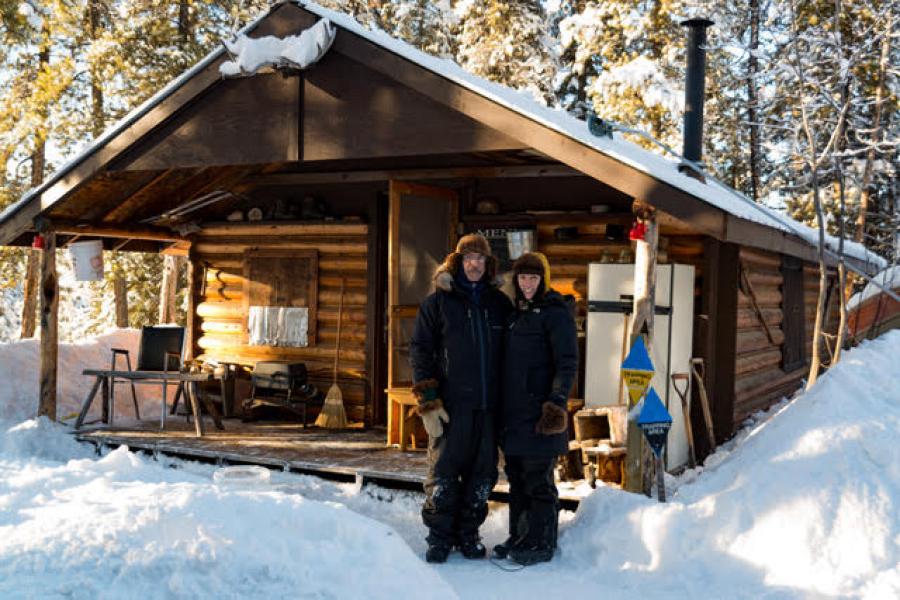In downtown Whitehorse, a 65-square-foot boutique faces the Yukon River. Handwoven tapestries hang on the white walls and Vanessa Ægirsdóttir’s fur jewelry lines the shelves and counters. The store, called V. Ægirsdóttir boutique, has only been open for a few months, but has already drawn local media attention and international interest and customers. By using ethically-trapped fur Ægirsdóttir’s wearable products present a new pathway to reconciliation—one that honours Indigenous cultures and traditions, yet fosters a sustainable business model for trappers.
Ægirsdóttir’s partner, George Bahm, a Tlingit trapper, is her main fur supplier. From his family’s traditional trapline, Bahm provides Ægirsdóttir with marten, lynx, fox, wolverine, and wolf fur—as available—with which she creates bracelets, earrings, rings, pendants, and more.
You may unsubscribe from any of our newsletters at any time.
The prices for her products are reasonable—you can buy a muskrat fur cocktail ring for $80 and red fox fur earrings for $60—but the couple says the business partnership is a stable source of money and is profitable for Bahm compared to the alternative. Trapline-acquired furs are typically sold at auction houses, where pricing fluctuates depending on supply and consumer trends. On the current market, Bahm says at the lowest price he can sell a lynx pelt for $75, and fox for $50. He told the Yukon News in January this is only half or a third of what trappers should be getting.

Despite the financial benefits, Bahm and Ægirsdóttir say their objective isn’t just monetary. What they are selling is a new strategy to encourage the traditional livelihoods of the territory’s First Nations. “The intent is we get more active trappers, and not only getting trappers back on the land, but making it profitable for them, making it viable,” says Bahm. “We want to support them by giving them a better price for their fur.”
Going out on the land and working a trapline is not always cost efficient in Canada’s north. In 2016, Andy Preto, a non-Indigenous Yukon trapper, told CBC News he calculated he was making less than a dollar an hour with fluctuating fur prices. “If you can make even $15,000 [in a year] you’re doing pretty good,” he said. Working his trapline in Haines Junction, a town located an hour and a half from Whitehorse, Preto said trapping was more of a lifestyle than a job.
But for Bahm, trapping is more than a hobby—it is his heritage and right as a Tlingit person. In his “day job,” he works with the Yukon department of education as a First Nations experiential advisor, going to territory schools and working with teachers to educate students on place-based (local) culture using language, song, dance and ancestral technology. But Bahm says he doesn’t like being in town too long, something he says is common among other First Nations people in the region. “I need to be out on the land,” he says. “This [partnership] is a way of carrying on a tradition that reaches more than one thing in my life. It allows me to be out there, it allows me to have an input and a say, it allows me to see what’s going on out there on my traditional territories.”
Ægirsdóttir is a textile artist who has lived in the Yukon since 2007, and although she had dabbled with fur in the past, she only really began creating artwork and jewelry with it after she met Bahm in 2016. “There’s a really vibrant trapping community [in Whitehorse], so the access to furs is really plentiful,” she says. Her wares depend on what is available: this season yielded mostly marten, lynx, and one wolverine. No wolf or fox this season, she says. “They’re out there but they’re sneaky.”
Bahm has been trapping in the area surrounding his family’s cabin, which is a four-hour drive from Whitehorse, for much of his life. It is only accessible by snowmobile in the winter and a truck in the summer. Bahm also invites friends and visitors to the cabin, many of whom are not Indigenous and are there to help out and learn about trapping.
https://www.instagram.com/p/BrIcIErnxtM/?utm_source=ig_embed
Joining Bahm on the trapline is important to Ægirsdóttir. “I like to accompany him on the trapping runs to visually participate in the harvesting of the fur so I could speak to that as a maker,” she says. “It’s really important to me to understand and whenever possible have experience in the origins of the material.” She hasn’t been able to accompany him into the wilderness much this winter because of the store’s opening and Christmas season orders, but says every weekend in January the two have been out running the traps, a length of about 180 kilometres.
Ægirsdóttir has also learned to skin, something that once made her squirm. On one trip, Bahm came home with a marten and his mom, who was visiting, wagged a finger at Ægirsdóttir and said, “You want to be a trapper, you gotta learn how to skin.”
“Cut to three months later and now I am like, ‘OK, I have four martens to skin. Two for you, two for me. Clock’s ticking, go!’” Ægirsdóttir says.
Gratitude, respect and humility are key to Bahm’s method of harvesting fur. “The method is so important and the intent,” he says. Traditionally, when Indigenous people went into the wilderness to harvest fur, they used quick-kill methods. Modern trapping technology has changed this, but Bahm says it is important to him that the animals do not suffer. “I believe that when you’re around our fur, when you touch it, you wear it, it should feel good, it shouldn’t feel like it was stressed out. So we try to make sure by all standards that the modern trapping methods align with our traditional values.”
With each product, Ægirsdóttir includes a card that explains where the fur comes from and how it was trapped. Part of it reads: “My partner, George has taught me that by wearing fur, we are forever in relationship with that animal and we are duty bound to remember the gift that animal has given to us.”
When the trapline is opened and closed, Bahm will make offerings and offer words of respect and gratefulness and thankfulness to the Creator, the specifics of which he does not want to share. “There’s some knowledge that’s meant to be shared so we can all grow, but there’s also some that just stays with us.”

The store opened in October and the couple says the reception has been positive. Ægirsdóttir says half of her customers are from the region while the other is largely tourists. She has even heard from some vegetarians, who, while not interested in buying the products, she says are supportive of the business and its ethics. As well as running the boutique, Ægirsdóttir says she has a healthy community of customers and supporters through her website and Instagram.
Although the boutique is doing well, Bahm and Ægirsdóttir are conscious of their role in Whitehorse as suppliers of fur products. Ægirsdóttir says she respects the work of local First Nations and so does not seek to compete with Indigenous artists. She doesn’t create mitts or hats, which are products traditionally made by Indigenous people. Rather, she says she is “hoping to establish this new standard of what is OK to do with fur.”
The couple hopes their partnership will inspire more artists to create products using material supplied by First Nations trappers. “If there are makers at that end of the supply chain, then that just means more success for our trappers,” says Ægirsdóttir.
“I think sometimes people don’t understand what it’s like to be First Nations but still living in this dominant society,” says Bahm. “We’re trying to bridge that gap, we’re trying to allow us as Indigenous people to be able to practice our traditional activities and have them recognized and respected.”














